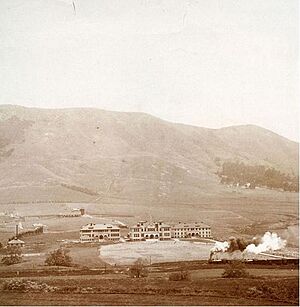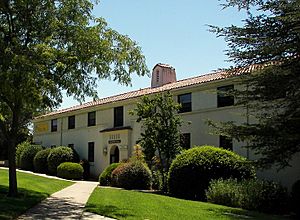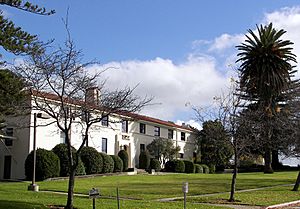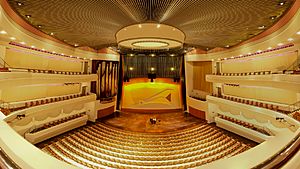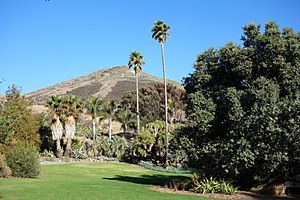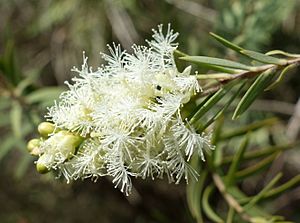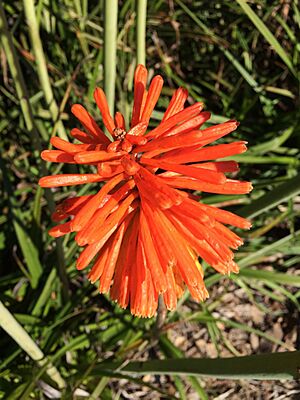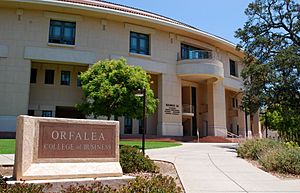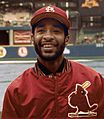California Polytechnic State University, San Luis Obispo facts for kids
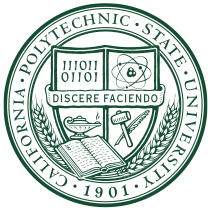 |
|
|
Former name
|
California Polytechnic School (1901–1947), California Polytechnic State College (1947–1972) |
|---|---|
| Motto | Discere Faciendo (Latin) |
|
Motto in English
|
"Learn by Doing" |
| Type | Public polytechnic university |
| Established | March 8, 1901 |
|
Parent institution
|
California State University |
| Accreditation | WSCUC |
|
Academic affiliations
|
Space-grant |
| Endowment | $285.3 million (2022–23) |
| President | Jeffrey D. Armstrong |
| Provost | Al Liddicoat (interim) |
|
Academic staff
|
1,469 (fall 2023) |
|
Administrative staff
|
1,630 (fall 2023) |
| Undergraduates | 21,947 (fall 2024) |
| Postgraduates | 895 (fall 2024) |
| Location |
,
,
United States
|
| Campus | Small suburb, 9,678 acres (3,917 ha) total; 1,321 acres (535 ha) main campus; 155 acres (63 ha) campus core |
| Newspapers | Mustang News, Cal Poly News |
| Colors | Green and Gold |
| Nickname | Mustangs |
|
Sporting affiliations
|
|
| Mascots |
|
 |
|
California Polytechnic State University, often called Cal Poly, is a public university in San Luis Obispo County, California. It's known for its "learn by doing" approach, where students get lots of hands-on experience. Founded in 1901, it's the oldest of three special "polytechnic" universities in the California State University system.
Cal Poly has many popular programs, including engineering, architecture, and business. As of fall 2024, about 21,947 undergraduate students and 895 graduate students attend the university. Most of Cal Poly's sports teams compete in the Big West Conference.
Contents
Cal Poly's History and Growth
How Cal Poly Started
Cal Poly began in 1901 as the California Polytechnic School. The governor of California, Henry Gage, signed the bill to create it. Classes officially started on October 1, 1903, with just 20 students. At first, it offered three-year high school level courses.
The school originally allowed both boys and girls to attend. In 1929, women were not allowed to enroll for a while, but they were welcomed back in 1956. By fall 2023, about half of all students at Cal Poly were female.
Becoming a College and University
In 1924, the California State Board of Education took control of Cal Poly. During the Great Depression, there were talks about turning the school into a state prison because of money problems. Luckily, Julian A. McPhee saved the school and became its president for 33 years.
In 1933, Cal Poly became a two-year technical and job-training school. By 1940, it started offering four-year Bachelor of Arts degrees. The first students to earn these degrees graduated in 1942. In 1947, the school changed its name to California State Polytechnic College to show it was offering more advanced education.
Expanding with New Campuses
In 1938, Cal Poly received a farm and school as a gift. Later, in 1949, the W.K. Kellogg Foundation gave the university an 812-acre horse ranch in Pomona, California. This ranch first became a satellite campus for Cal Poly. However, in 1966, it became its own independent university, now known as Cal Poly Pomona.
Joining the CSU System
In 1960, Cal Poly San Luis Obispo, along with other state colleges, became part of the new CSU system. That same year, a tragic plane crash occurred, resulting in the loss of 16 Cal Poly football players and others.
Cal Poly began offering Master of Science degrees in 1967. Between 1967 and 1970, the university organized its studies into specialized schools, like the School of Science and Mathematics. In 1968, Cal Poly's radio station, KCPR, started broadcasting.
In 1971, the state officially renamed the school California Polytechnic State University. Since the 1970s, more and more students have joined, and the campus has grown a lot.
Recent Developments and Big Gifts
On May 3, 2017, Cal Poly received a huge gift of $110 million from former students William L. and Linda Frost. This was one of the biggest donations ever given to public education in California.
In 2024, the CSU system decided to combine Cal Maritime with Cal Poly San Luis Obispo. This change was approved on November 21, 2024. Starting July 1, 2025, the two universities will operate as one, simply called Cal Poly. All students from both schools will be enrolled as Cal Poly students by fall 2026.
Exploring the Cal Poly Campus
Cal Poly is located in an area just outside the city of San Luis Obispo. It has one of the largest college campuses in the United States, covering 9,178 acres. This makes it the second-largest university in California in terms of land.
The university's property includes the main campus, two areas for farming, and two sites in Santa Cruz County, California. The Swanton Pacific Ranch, a 3,200-acre ranch, offers hands-on learning and research opportunities. It helps students learn about farming, livestock, and forestry, supporting Cal Poly's "Learn by Doing" philosophy.
New Buildings and Spaces
In summer 2018, a new student housing area was finished. It has seven buildings with 1,475 beds for first-year students, plus a parking garage. There are also common areas like a café, game room, and outdoor sports courts.
The Warren J. Baker Center for Science and Mathematics opened on November 1, 2013. This large, six-story building cost $119 million and has modern labs, classrooms, and offices for science programs.
The William and Linda Frost Center for Research and Innovation was opened on May 5, 2023. This 102,000-square-foot center provides advanced labs and teaching spaces for students and teachers in science, agriculture, and liberal arts.
Getting Around Campus
Parking on campus can be limited, so Cal Poly encourages students to use other ways to get around. There are over 7,000 bike rack spaces and 252 secure bike lockers. Many students and staff live close enough to bike to campus.
The city's SLO Transit bus system also serves the campus. Cal Poly helps fund this, so students and staff can ride the buses for free. This helps reduce the number of cars on campus.
Leaning Pine Arboretum
The Leaning Pine Arboretum is a beautiful 5-acre garden on the north side of campus. Students help take care of it. In 2022, the arboretum received a generous one-million-dollar gift.
The gardens feature hundreds of different plants, especially those from areas with a Mediterranean climate, like California, Australia, and South Africa. It also has a New Zealand garden, a special garden for small evergreen trees, and displays of palms and succulents. The arboretum is open to the public for free.
Academics at Cal Poly
University Colleges
As of 2020, Cal Poly offers many different degrees and programs through its six colleges:
- College of Agriculture, Food and Environmental Sciences
- College of Architecture and Environmental Design
- Orfalea College of Business
- College of Engineering
- College of Liberal Arts
- Bailey College of Science and Mathematics
Senior Projects
All undergraduate students at Cal Poly must complete a "senior project." This is a big project that combines everything they've learned in their studies. It can be a design, an experiment, a research paper, or even a performance. These projects often help students get job offers or special recognition. For example, the idea for the popular company Jamba Juice came from a senior project!
How to Get In
New Student Statistics (Fall)
| 2024 | 2023 | 2022 | 2021 | 2020 | 2019 | |
| Applicants | 68,604 | 63,955 | 58,944 | 54,570 | 52,371 | 54,072 |
| Accepted | 21,416 | 18,964 | 17,885 | 18,008 | 20,127 | 15,366 |
| % Accepted | 31.2 | 29.7 | 30.3 | 33 | 38.4 | 28.4 |
| Enrolled | 5,276 | 5,270 | 5,111 | 4,884 | 4,788 | 4,613 |
| Average GPA | 4.12 | 4.03 | 4.04 | 4.01 | 3.99 | 3.99 |
Cal Poly is considered a "more selective" university, meaning it's competitive to get in. For students starting in fall 2025, about 28% of applicants were accepted.
When you apply to Cal Poly, you choose your major right away. The university then accepts the best applicants for each specific major. If students want to change their major later, they usually need to meet certain class and GPA requirements.
For fall 2024, Cal Poly accepted about 19.5% of new transfer students. The incoming class of first-year students in 2024 was made up of about 50% women and 50% men.
University Rankings
Cal Poly in San Luis Obispo has been ranked as the best public master's-level university in the Western United States for 32 years in a row by U.S. News & World Report. This publication also named Cal Poly the best overall master’s-level university (public or private) in the West in both 2023 and 2024. Regional universities offer many undergraduate programs and some master's programs, but few doctoral programs.
U.S. News & World Report (2025) rankings include:
- Regional Universities West - 1st
- Most Innovative Schools - 1st
- Best Undergraduate Teaching - 1st
- Top Public Schools - 1st
- Best Colleges for Veterans - 1st
- Best Value Schools - 7th
- Engineering Programs - 8th
- Civil Engineering - 1st
- Computer Engineering - 1st
- Electrical / Electronic / Communications Engineering - 2nd
- Mechanical Engineering - 2nd
Cal Poly is also highly ranked for its architecture and design programs. For example, its undergraduate architecture programs are ranked 3rd in the nation.
Student Life at Cal Poly
| Race and ethnicity | Total | ||
|---|---|---|---|
| White | 50% |
|
|
| Hispanic | 23% |
|
|
| Asian | 14% |
|
|
| Two or more races | 11% |
|
|
| International | 1% |
|
|
| Black | 0.7% |
|
|
| Pacific Islander | 0.3% |
|
|
| Native American | 0.1% |
|
|
| Economic diversity | |||
| Low-income | 14% |
|
|
| Affluent | 86% |
|
|
Where Students Live
Cal Poly has the largest student housing program in the CSU system, with 6,239 spaces. In Fall 2015, almost all (98.7%) first-year students lived on campus in one of the 28 dorms. Many second-year students also live on campus.
There are different types of residence halls, including North Mountain Halls, Red-Brick Halls, Sierra Madre and Yosemite Halls, Cerro Vista Apartments, Poly Canyon Village, and Yakʔitʸutʸu residence halls.
Welcome Week for New Students
The Week of Welcome (WOW) is a special program for new students that happens in September. Volunteers help new students get to know the campus and community. First-year students are put into small groups, and transfer students into larger groups, each led by current student leaders. These groups do fun activities and learn about college life. WOW is one of the largest volunteer orientation programs in the country.
Recreation and Clubs
The Cal Poly Recreation Center is a modern gym and activity center for students on campus.
Cal Poly has over 150 recognized clubs and student organizations. These include cultural clubs, science clubs, improv groups, religious groups, and many more. There are also engineering clubs, sports teams, and academic honor societies.
Cal Poly Sports and Athletics
Cal Poly has 20 sports teams (10 for men and 10 for women) that compete in NCAA Division I. Most teams are part of the Big West Conference. However, the football team plays in the Big Sky Conference, and the wrestling team is in the Pac-12 Conference.
Before 1994, Cal Poly won 35 national championships in NCAA Division II. The university has two mascots: Musty the Mustang and Chase, a real mustang horse.
Club Sports
Besides NCAA sports, Cal Poly also has many club sports. For example, the college rugby team often ranks among the top 25 nationwide. The ultimate frisbee team, SLOCORE, has also been a top team, reaching its first national final in 2024.
Rivalries and Bands
The Battle for the Golden Horseshoe is an annual football game between the UC Davis Aggies and the Cal Poly Mustangs. The Mustang Marching Band, with over 200 members, performs at football, basketball, and volleyball games.
How Cal Poly is Organized
Cal Poly is divided into four main parts:
- Academic Affairs: This includes the six colleges, the Library, and research programs.
- Student Affairs: This part focuses on student life and support.
- Administration and Finance: This handles the university's money and operations.
- University Advancement: This group works on fundraising and connecting with alumni.
University Support Groups
Cal Poly Partners: This group helps the university with business, money, and support services. It was founded in 1940.
Cal Poly Foundation: This organization accepts and manages donations to the university. It helps with fundraising and managing the university's money.
Cal Poly Extended Education: This offers degrees, certificates, and professional programs for people in the local area and online.
Associated Students Inc. (ASI): This is a non-profit group run by Cal Poly student leaders. ASI organizes events, speakers, concerts, sports, fitness programs, and more. It also manages the University Union, Recreation Center, and Children's Center on campus.
Alumni Association: This group connects with former students, helping them stay in touch with the university and support its mission.
Leaders of Cal Poly
- Leroy Anderson, 1902–1907
- Leroy Burns Smith, 1908–1914
- Robert Weir Ryder, 1914–1921
- Nicholas Ricciardi, 1921–1924
- Margaret Chase (Acting), 1924
- Benjamin Ray Crandall, 1924–1933
- Julian A. McPhee, 1933–1966
- Dale W. Andrews (acting), 1966–1967
- Robert E. Kennedy, 1967–1979
- Warren J. Baker, 1979–2010
- Robert Glidden (Acting), 2010–2011
- Jeffrey D. Armstrong, 2011–present
Famous People Who Went to Cal Poly
See a full list of notable alumni of Cal Poly in San Luis Obispo
Cal Poly has over 150,000 former students, called alumni. Many of them live in San Luis Obispo, Santa Clara, and Los Angeles counties.
- Tory Bruno, CEO of ULA
- Gregory Chamitoff, NASA astronaut
- Danding Cojuangco, former chairman and CEO of San Miguel Corporation
- Robert "Hoot" Gibson, NASA astronaut
- Victor Glover, NASA astronaut
- Mike Krukow, professional baseball player and broadcaster
- Noel Lee, founder of Monster Cable
- Abel Maldonado, former California Lt. Governor
- John Madden, professional football player and broadcaster
- Farzad Nazem, former Chief Technology Officer of Yahoo
- Joe Prunty, professional basketball coach
- Devin Nunes, former U.S. Representative
- David Nwaba, professional basketball player
- Peter Oppenheimer, former Chief Financial Officer of Apple Inc.
- Kirk Perron, founder of Jamba Juice
- Burt Rutan, pioneering aerospace engineer
- Ozzie Smith, professional baseball player
- Rick Sturckow, NASA astronaut
- William Swanson, CEO of Raytheon
- M. Ward, musician
- "Weird Al" Yankovic, musician
- Maya Higa, conservationist & online personality
Images for kids
See also
 In Spanish: Universidad Politécnica Estatal de California para niños
In Spanish: Universidad Politécnica Estatal de California para niños
- California Master Plan for Higher Education
External links
- Cal Poly Athletics website
- Calpoly.edu: official Leaning Pine Arboretum website: https://aeps.calpoly.edu/leaning-pine-arboretum/visiting-lpa


